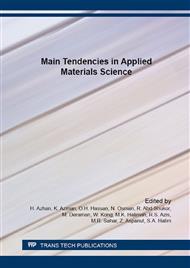[1]
B. P. Mooney, The second revolution? Production of plant-based biodegradable plastics, Biochem J., 418 (2009) 219–232.
DOI: 10.1042/bj20081769
Google Scholar
[2]
L. Zan, W. Fa and S, Wang, Novel photodegradable low-density polyethylene–TiO2 nanocomposite film, Environ. Sci. Technol., 40 (2006) 1681–1685.
DOI: 10.1021/es051173x
Google Scholar
[3]
Y. Chen, Advantages of bioplastics and global sustainability, Applied Mechanics & Materials, 420 (2013) 209–214.
DOI: 10.4028/www.scientific.net/amm.420.209
Google Scholar
[4]
A. Malik, S. Parveen, T. Ahamad, S. M. Alshehri, P. K. Singh and N. Nishat, Coordination polymer: Synthesis, special characterization and thermal behaviour of starch-urea biodegradable polymer and its polymer metal complexes, Bioinorganic Chemistry and Applications, (2010).
DOI: 10.1155/2010/848130
Google Scholar
[5]
J. Doran-Peterson, D. M. Cook and S. K. Brandon, Microbial conversion of sugars from plant biomass to lactic acid or ethanol, Plant J., 54 (2008) 582–592.
DOI: 10.1111/j.1365-313x.2008.03480.x
Google Scholar
[6]
J. M. L. Dias, P. C. Lemos, L. S. Serafim, C. Oliveira, M. Eiroa, M. G. E. Albuquerque, A. M. Ramos, R. Oliveira and M. A. M. Reis, Recent advances in polyhydroxyalkanoate production by mixed aerobic cultures: from the substrate to the final product. Macromol. Biosci., 6 (2006).
DOI: 10.1002/mabi.200600112
Google Scholar
[7]
M. A. Araújo, A. Cunha and M. Mota, Enzymatic degradation of starch-based thermoplastic compounds used in protheses: Identification of the degradation products in solution. Biomaterials, 25 (2004) 2687–269.
DOI: 10.1016/j.biomaterials.2003.09.093
Google Scholar
[8]
J. F. Zhang and X. Z. Sun, Mechanical properties of PLA/starch composites compatibilized by maleic anhydride. Biomacromolecules, 5 (2004) 1446–1451.
DOI: 10.1021/bm0400022
Google Scholar
[9]
G. J. L. Griffin, Starch polymer blends. Polymer Degradation and Stability, 45 (1994) 241–247.
DOI: 10.1016/0141-3910(94)90141-4
Google Scholar
[10]
R. F. T. Strepto, Understanding the processing of thermoplastic starch, Macromolecular Symposia, 245 (2006) 571–577.
Google Scholar
[11]
J. Delville, C. Joly, P. Dole and C. Bliard, Influence of photocrosslinking on the retrogradation of wheat starch based films, Carbohydrate Polymers, 53(4) (2003) 373–381.
DOI: 10.1016/s0144-8617(03)00141-3
Google Scholar
[12]
S. Khoramnejadian, J. J. Zavareh and S. Khoramnejadian, Effect of potato starch on thermal and mechanical properties on low density polyethylene, Current World Environment, 8(2) (2013) 215–220.
DOI: 10.12944/cwe.8.2.06
Google Scholar
[13]
M. B. Musa, M. J. Yoo, T. J. Kang, E. G. Kolawole, U. S. Ishiaku, M. K. Yakubu and D. J. Whang, Characterization and Thermomechanical Properties of Thermoplastic Potato Starch, Journal of Engineering and Technology, (2013) 9-16.
Google Scholar
[14]
H. Szczepanowska and W. Wilson, Permanancy of reprographic images on polyester film, Journal of American Institute for Conservation, 39(3) (2000).
DOI: 10.1179/019713600806113185
Google Scholar
[15]
A. P. R. Monica, L. R. Q. Bernabe and R. Saddys, Polypropylene/starch blends: Study on thermal and morphological properties, J. Chil. Chem. Soc., 58(1) (2013).
Google Scholar
[16]
H. A. M. Wickramasinghe, S. Takigawa, C. Matsuura-Endo, H. Yamauchi and T. Noda, Comparative analysis of starch properties of different root and tuber crops of Sri Lanka, Food Chemistry, 112 (2009) 98–103.
DOI: 10.1016/j.foodchem.2008.05.046
Google Scholar
[17]
A. Moongngarm, Chemical Compositions And Resistant Starch Content In Starchy Foods, American Journal of Agricultural and Biological Sciences, 8 (2): 107-113, (2013).
DOI: 10.3844/ajabssp.2013.107.113
Google Scholar
[18]
K. Scott-Dixon and B. St. Pierre, Sweet vs. regular potatoes: Which potatoes are really healthier?, http: /www. precisionnutrition. com/regular-vs-sweet-potatoes.
Google Scholar


